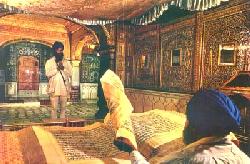

![]()

The Harmandir Sahib
 |
 |
Vision
Siri Guru Arjan Dev Ji envisioned a temple that would be made the repository of the Sikh religion, a reflection of its resoluteness and its strength. It would become the hallowed symbol of the indestructibility of the faith. It would be known as the Harmandir.
The plan he conceived for the Harmandir was designed to reflect the clarity, simplicity and logic of the new movement. Its location in the center of the pool would symbolize the synthesis of nirgun and sargun: the spiritual and temporal realms of human existence.
Siri Guru Arjan Dev reversed the prevalent practice of designing high temple plinths. By building the Harmandir at a level lower than the surrounding land, he wanted to emphasize the inner strength that was provided by the faith, rather than draw attention to its external manifestations.
Unlike traditional temple architecture that provided only one entrance, the Harmandir would have four, one on each side. Its doors would thus be open to all the four castes, for to Siri Guru Arjan Dev Ji, "the four castes of Kshatriyas, Brabmins, Sudras and Vaisyas are equal partners in divine instruction."
The principle of universal participation was extended to the planning and execution of the project. All Sikhs in all congregations had a role in building this noble edifice to their faith. Their participation took two forms: voluntary labor (sewa) at the site, and a donation (daswandh) of ten percent of their income to support the construction. Both these practices have endured ever since. While clearly not all Sikhs give ten percent of their earnings towards the upkeep and improvement of their Gurdwaras (Sikh temples), the offerings of the devotees are not inconsiderable. The tradition of voluntary service too has remained unchanged from the time the sarowar and the Harmandir were built.
Foundation
| Though Siri Guru Arjan Dev Ji's role was central to the realization of idea of a sacred shrine, the Darbar Sahib does not reflect the concept of a single designer or master builder. The complex evolved over the centuries. It grew as the passionate adherents of the faith poured their energies, resources and skills into building something wondrous. Ironically, the calamitous events that were to befall the Sikhs, and the savagery and wantonness with which the shrine they revered was repeatedly destroyed, contributed towards its increasing magnificence as they embellished and adorned it still further each time it was rebuilt. Its ultimate grandeur was the outcome of the labor and love of the many generations who reconstructed it after each attempt at its destruction. |
There is no agreement on who actually laid the foundation stone of the Harmandir, nor the year in which it was laid. Some hold it was Mian Mir, a Sufi saint of Lahore who performed the ceremony at the invitation of the guru. With many written records destroyed in the unending battles fought over the Darbar Sahib, oral tradition remains the source for much of the information of that period.
Sarowar
By the time the Harmandir's foundation stone was laid, the sarowar had been lined with bricks and steps had been built along its sides so that the devout could bathe in the immortal pool. The original structure in the pool was modest in scale, and built with simple materials, in stunning contrast both to the Renaissance buildings of that period in Europe, with their ornamentation and richness, and to the splendor and scale of those that India's Islamic rulers were building.
It offered its adherents something more inspiring: an abiding sense of spiritual reassurance, an unshakeable confidence in the Sikh gospel of God's accessibility to all and, by a philosophy of reconciliation, a convincing way out of the mood of despair generated by the claims of the competing religions of that time.
Because of his emphasis on the spiritual rather than the material, Siri Guru Arjan Dev Ji chose to build a small structure in burnt brick and lime, in the center of this "pool of nectar" and to construct a causeway over the water to reach it. He wanted its design to reflect the directness and simplicity that he felt to be characteristic of Sikh beliefs. The gilding, marble, mirror and inlay work were to come much later, in the nineteenth century, when a proud people, having reached the pinnacle of their power and affluence during Maharajah Ranjit Singh's reign (1799-1839), lavished their wealth on increasing the magnificence of their shrine at Amritsar.
The Construction of the Harmandir
In 1589 the scope of the project was confined to building the Harmandir in the pool. First, a solid brick and lime foundation above the bed of the pool was erected. On it came thick supporting walls. The causeway connecting to the western bank of the pool was built over aqueducts-(52 in number). Along the four sides of the pool, the ground was leveled for the parkarma, (circumambulation). Since the steps going down into the pool had already been built for bathing, the core of the complex had now taken shape.
Whether through design or accident, the visual relationship of the pool with the Harmandir in its center, the length of the causeway that connects the shrine to the parkarma, which in turn takes devotees around the sacred waters, all seem part of a rational progression. It is easy to relate to it, since neither the scale of the parkarma around the pool, nor the proportions of the buildings surrounding it, appear designed to dominate.
Yet a feeling of quiet strength, a sense of drama comes through with the first view of the Darbar Sahib as it is experienced by those who step down the stairs that lead to the level of the parkarma. There, shimmering in the hallowed pool, proud and serene, stands the redoubtable Harmandir. It takes a while to absorb the scene, to come to grips with the long-awaited sight every Sikh has yearned for. But even this is only the beginning, for the feeling of excitement does not end here. If anything, it is the start of yet another level of expectation, as the established custom of turning left along the parkarma is followed. The clockwise circumambulation to the Harmandir, alongside the hallowed pool, gives time for contemplation, for a necessary spiritual reorientation, for adjusting to and marveling at this reality that has thus far been a dream the devout have nurtured.
Compilation of The Siri Guru Granth Sahib
Siri Guru Arjan Dev Ji was convinced that the devotion of a people, who came for a profound experience to the fountainhead of their faith, would not be sustained by an empty structure. With that in mind, he had already embarked on an ambitious project of compiling the Sikh scriptures: an anthology of the teachings, hymns, thoughts and verses of the first five gurus, and of Hindu and Muslim scholars and saints, like Kabir, Namdev, Ravidas, Sheikh Farid and others.
He wanted the Harmandir to be synonymous with the best that men of wisdom and divine inspiration had to offer. It must become the repository of rational thought, not blind belief. People no doubt had to be held in thrall by the devotional dimension of the scriptures recited in it. Even more, the message of the scriptures had to be logical, set to the ragas (the classical system of Indian music), so that the rationality of thought was rendered lyrically.
The original volume of the Siri Guru Granth Sahib Ji consisted of 1,948 pages containing more than 7,000 hymns. The writings of the gurus, in chronological order, are followed by the works of the saints and sufis. They are composed in 31 ragas, with the compositions framed to an exacting method, corresponding to the time of the day and the different moods. Yet, since faith must lead to a balanced outlook, the joyous and the sad are subtly interwoven with moods of yearning and rejoicing. The Gurmukhi script was used throughout the book, even where the original hymns were composed in medieval Punjabi, Hindi and other languages of the time.
Siri Guru Arjan Dev Ji's efforts at compilation were prodigious, and his own contribution to the text of the Siri Guru Granth Sahib Ji enormous. His editing standards were also meticulous, both with regard to the content and to the syntax, style and rhythm that would help the natural flow of the text. Thus was born the Adi Granth, the holy book of the Sikhs -generally known as the Siri Guru Granth Sahib-which would be installed in the Harmandir in 1604, three years after the completion of the shrine in the pool.
The manuscript on which Siri Guru Arjan Dev worked still exists at Kartarpur. Though the manuscript to which Siri Guru Gobind Singh, the tenth and last guru, added the hymns of his father Tegh Bahadur was destroyed, a copy made by his followers fortunately survives.
The high level of sanctity and reverence accorded to the Harmandir could not have been possible without the Siri Guru Granth Sahib located in it. A religion that stresses rationality, like Sikhism, would have been unable to sustain its momentum in a vacuum. A compilation of the philosophical and ethical insights of the wise men of that age was as logical a move as its installation at the Harmandir.
The Siri Guru Granth Sahib Ji was made the fountainhead of the Sikh religion by Siri Guru Gobind Singh Ji. Just before his death in 1708, he ended a hundred years of the guru tradition by enjoining his followers to look to the Siri Guru Granth Sahib as the supreme Guru. They were to worship its wisdom and knowledge from then on.
 |
The elevation of the Siri Guru Granth Sahib to the status of a guru, which was an unusual concept of leadership, was to work admirably over the centuries, with the scriptures providing spiritual direction to the Sikhs. Whether in tragedy or triumph, rejoicing or grief, the people would turn to the Siri Guru Granth Sahib for philosophical insights and guidance, and it would, in time, find a place in most Sikh homes. As the art of calligraphy yielded to newer methods of printing, the size of the book was fixed at 1,430 pages, with every copy anywhere in the world standardized to this length. |
From the very day the first copy of the Siri Guru Granth Sahib was taken ceremonially to the Harmandir, till the present time, it is customary to take it with the same ceremony every morning from the Akal Takht-where it is kept each night-to the Harmandir. Passages are read from it throughout the day, interspersed with the singing of excerpts, so that those who come to sit and listen will leave enriched by the words of their spiritual forefathers.
